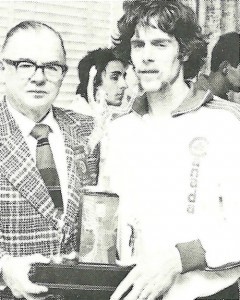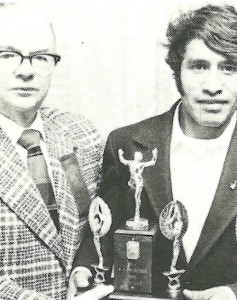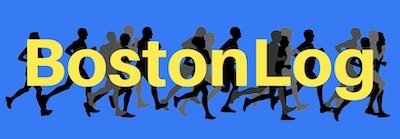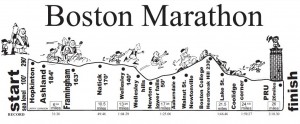The 1975 Boston Marathon:
An Incredibly Fast Race
BY ED BORSCH
[Originally published in the Runner’s Gazette, and reprinted here with permission]
Imagine a major marathon today, other than the Olympics or World Championships, in which almost 90% of the entire field broke 3 hours and 30 minutes. Such was the case on April 21, 1975 at the 79th annual Boston Marathon. 1,846 men & women finishers out of a starting field of 2,090 broke 3:30. Remarkably, this occurred despite the lack of any race clocks along the course, no pace setters, and no official mile or kilometer markers or timers at the standard checkpoints.
Quality-wise, the results were incredible:
Liane Winter of West Germany set a new women’s world record with her 2:42:24;
the American men’s record of Frank Shorter (2:10:30) was broken by Bill Rodgers with a 2:09:55;
22 finishers broke 2:20;
50th place was 2:24:19;
888 men and 7 women (43% of the total field) broke 3 hours; and finally,
the top 10 men improved their PRs by an average of 4:05.
How was such an overall quality finish possible? Well, like today, the Boston Athletic Association had qualifying time standards. They were simpler though, as stated on the race application, “No times or places will be recorded after 3:30 p.m.” In other words, if you couldn’t finish by 3:30, your effort wouldn’t be recorded.
As the 1975 race itself, and for background purposes, the previous year (1974) had been a fast Boston. Neil Cusack of East Tennessee State and Ireland, won in a collegiate record of 2:13:39. Tom Fleming of New Jersey finished 2nd again with a PR of 2:14:25, while Jerome Drayton of Canada was 3rd in 2:15:40. Six of the top 10 fastest times run by Americans on the Boston course were set in this 1974 race.
Up and coming, but still relatively unknown, Bill Rodgers of the Greater Boston Track Club, had run poorly the previous two Bostons. He had dropped out in 1973 after 21 miles. Bill was 4th at 18 miles in 74, then his legs went on him, resulting in a 14th place of 2:19:34, his PR.
The Jamaica Plains resident had run very well during the preceding twelve months leading up to the ’75 Boston. He won the Philadelphia Marathon in 2:21:57 on December 1, 1974. Then in early March 1975, he demonstrated for the first time his world class abilities as he finished 3rd in the world cross-country championships in Rabat, Morocco (12K). Bill beat many of the world’s best runners, including America’s 1972 Olympic champion, Frank Shorter, Belgians’ Gaston Roelants and Emiel Puttemans, and John Walker of New Zealand.
Other than his coach Billy Squires, and trainer, Jock Semple, no one in the Boston press picked Rodgers to win. Ron Hill, the course record holder at 2:10:30, 1969 Fukuoka marathon champion Jerome Drayton of Canada, Tom Fleming, and Richard Mabuza of Swaziland were mentioned the most. Frank Shorter was again not in Boston as the BAA did not pay appearance fees or travel costs, let alone give prize money.
Tom Fleming of New Jersey, who had finished second in Boston in 1973 and ’74, was very confident. His training had gone well, especially during March when he worked out together with Neil Cusack. Not only was their mileage prodigious, but the pace on their long runs boded well for a successful run in Boston. Neil was so impressed with Fleming’s fitness and strength, he didn’t feel anyone could touch Tom in ’75. Having a PR 5 minutes faster than Rodgers contributed to Tom’s confidence.
The weather conditions were perfect on race day. Temps were in the low to mid 50s. There were strong quartering winds out of the northwest with gusts of 25 MPH.
After the gun sounded at noon in Hopkinton, the pace was quick. Bernie Allen from England went out first, like the previous year, leading into Framingham.

Framingham (6.72 miles)
Record split—31:26
1. B. Allen–31.55–4:45 per mile pace
2. Wade Brown–US Army
3. R. Mabuza–Swaziland
4. Ron Hill–England
5. Tom Howard–Canada
6. Mario Cuevas–Mexico
7. J. Drayton–Canada
8. T. Fleming–USA
9. B. Rodgers–USA
10. Steve Hoag–USA
(Estimated split at 5 miles–23:45)
Just after Framingham (around the 6 3/4 mile point), Drayton and Cuevas went after Allen and took over the lead. Rodgers, knowing he couldn’t let Drayton get too far ahead, joined the chase. About a mile later Rodgers caught the new leader, Drayton, probably around eight miles. The competitiveness of Drayton and Rodgers got the best of them as they both threw caution to the wind and continued to push themselves at a 4:47 pace, each trying to break the other. Coming into Natick, Rodgers hung stride for stride with Drayton.

Natick (10.42 miles)
Record split—49:46
1. J. Drayton–49:48–4:46.7/mile pace
2. Bill Rodgers
3. M. Cuevas
4. Tom Howard
5. R. Mabuza
6. T. Fleming
7. R. Hill
8. W. Brown
9. S. Hoag
10. B. Allen
(Estimated 10 mile split was 47:47 with the second 5 miles covered in 24:02)
Drayton and Rodgers ran shoulder to shoulder along the undulating roads into Wellesley. Entering Wellesley, Rodgers had gained a 10-yard lead. It wasn’t until near Wellesley Square (13.4 miles), just past the halfway mark, Rodgers really started to pull away from Drayton, getting 30 yards on him, resulting in a now record split of 1:04:18.
Despite the leads of Rodgers and Drayton, Fleming was not worried.
“They were within sight, only about 100 yards ahead. I felt I could easily make this distance up when the real race started in the Newton Hills.”
Wellesley Square (13.41 miles)
Record Split 1:04:29
1. B. Rodgers –1:04:18–4:47 per mile
2. Drayton
3. Cuevas
4. Howard
5. Mabuza
6. Fleming
7. Hill
8. Hoag
9. Dennis Williams, New Mexico
10. John Vitale, Connecticut
Based on these splits, Bill’s half-marathon time is estimated around 1:02:51. His split at 13.41 mile mark means he was still going at a pace of 4:47 per mile.
Despite knowing he had already gone too fast, Bill continued to push the pace down the hills out of Wellesley in order to further build his lead. The crowds had drawn him out, making him go faster than he planned. As Bill related afterwards to reporters, “at 10 miles, I knew I was too fast. At 17 miles I was convinced of it.”
(Estimated 15 mile split was 1:11:57; 3rd 5 miles covered in 24:10).
Bill’s downhill running ability paid off in this section from Wellesley to Newton Lower Falls as he, in effect, won the race here.
Auburndale (17.61 miles)
Record Split 1:25:06
- B. Rodgers –:24:28–cumulative pace to this point 4:48!
2. Drayton
3. Cuevas
4. Howard
5. Fleming
6. Hoag
7. Hill
8. Mabuza
9. Jim Stanley
10. Williams
Rodgers had run the Natick to Auburndale section (from 10.42 mile mark to 17.61 miles) in a record 34:40.
Surprisingly, Rodgers ran with more caution once he turned onto Commonwealth Avenue in Auburndale. As he headed into the hills, he feared he would “blow up” and would have nothing left if Drayton came up on him. These upcoming three hills had ruined his races the previous two years, so he was wary of continuing to push the pace.
Lake Street (21.67 miles)
Record Split 1:46:46
1. B. Rodgers –1:46:03–cumulative pace to this point, now 4:53.6
2. Drayton
3. Fleming
4. Hoag
5. Howard
6. Cuevas
7. Hill
8. Russ Pate
9. Stanley
10. Peter Fredriksson—Sweden
From Auburndale (17.61) to Lake Street (21.67): Bill covered the hills in 21:35 or 5:19 per mile, a dramatic slowdown. He had stopped for water a few times and also to tie his shoes in this stretch.
(Probable 20 mile split was 1:37:10. The fourth 5 miles covered in 25:13).
Despite running well to this point, Fleming, was having difficulty believing how easily Rodgers had run away from him. He could still see Bill with his motorcycle escort up ahead, but try as he might, he couldn’t make a dent in this lead. Tom was learning what many runners would realize in the next five years,
“Bill was just faster than me and he had trained just as hard.”
Coolidge Corner (24.14 miles)
Record Split 1:59:27
1. B. Rodgers –1:58:39
2. Fleming
3. Hoag
4. Howard
5. Hill
6. Cuevas
7. Pate
8. Stanley
9. Fredriksson
10. Andrew Boychuk–Canada
From the Lake Street checkpoint to Coolidge Corner (24.14 miles) Rodgers was able to pick up the pace again to 5:06 per mile in this mostly downhill and flat stretch. Bill stated he was “cooling it” over the final miles, still fearing that Drayton would go flying by him like he had in 1974. Unknown to Bill, Drayton dropped out around Coolidge Corner.
Only 2 1/4 miles now from the finish, Rodgers’ overall pace projected a finish time of 2:09:12, well over a minute under Frank Shorter’s American Record. Unfortunately, Bill was most likely unaware of exactly where he stood pace wise, and covered the last 2+ miles at a 5:26 per mile pace.
When he finished, Bill was widely quoted as thinking he had run a 2:15 minute marathon. He was utterly astonished to learn his time was 2:09:55. It was the fourth fastest marathon ever run at that time. Rodgers was the first Bay Stater to win Boston in 30 years. (John A. Kelley won in 1945.)
Fleming, after seeing Drayton had dropped out, found himself in 2nd place again. Steve Hoag of Minnesota was right behind Tom as they headed up Hereford Street, about a quarter-mile from the finish. Disappointed with a possible third consecutive 2nd place finish, Fleming was “bummed out” and waved Hoag by, settling for a 3rd place. In hindsight, Tom regretted this action. Nevertheless, with the first 3 places going to Americans, this was an outcome had not seen since the 1942 race. Tom’s 2:12:05 would be the fastest marathon of his career.
1975 Final Results
1. Bill Rodgers –2:09:55
2. Steve Hoag- Minnesota –2:11:54
3. Tom Fleming–New Jersey –2:12:05
4. Tom Howard–Canada–2:13:23
5. Ron Hill–England –2:13:28
6. Jim Stanley–Ohio–2:14:54
7. Russ Pate–South Carolina –2:15:22
8. Peter Fredriksson–Sweden –2:15:38
9. Mario Cuevas–Mexico–2:16:03
10. Andrew Boychuk–Canada–2:16:13
One can’t help what wonder, if Rodgers had known how fast he was running, could he have broken the world best as well? When looking at his splits halfway and as late as Lake Street (4 3/4 miles from the finish), a world record was within Bill’s reach.
Split-times were taken and shouted to the leaders by the BAA officials at the traditional Boston checkpoints. However, these checkpoint splits made no sense to the runners. How could they at distances like 6.72 miles, 10.42, 13.41, 17.61, 21.67, and 24.14 miles?
Reviewing the split times presented here, we see from Auburndale to the finish, Rodgers ran this final 8.61 mile section in 45:27, a pace of 5:16.7 per mile. He had run 4:48/mile for the first 17+ miles, then only 5:16 per mile pace to the finish, a significant slowdown. His first half was in 1:02:51 (4:47 per mile) and 2nd half in 1:07:04 (5:07 per mile).
Had Rodgers been able to maintain at least a 5:06 per mile pace instead of the 5:16 over the last 8.61 miles, he would have run a 2:08:22 marathon, breaking the existing world record of 2:08:33 set by Australia’s Derek Clayton in Antwerp, Belgium in 1968.
Nevertheless, Bill’s focus was rightly on winning, not setting records. Justifiably fearing his legs could cramp again, he ran cautiously over the last eight miles, and especially the final two miles.
One also has to remember, there were no direct financial rewards or prize money for winning Boston or breaking records. Rodgers, like almost all the elite runners in this era, had to work full time to support himself. Although he wore a pair of Nikes sent to him from Eugene by Steve Prefontaine, he was not on any shoe company’s payroll.
In summary, the records set that day were a by-product of the competitiveness of the elite athletes, especially Rodgers, Drayton, Hoag, and Fleming; as well as the very favorable conditions. Had there been a lead vehicle with a clock ahead of Bill and the other leaders the whole way, as well as splits at the standard mile marks, it is hard to imagine this race being any different.

